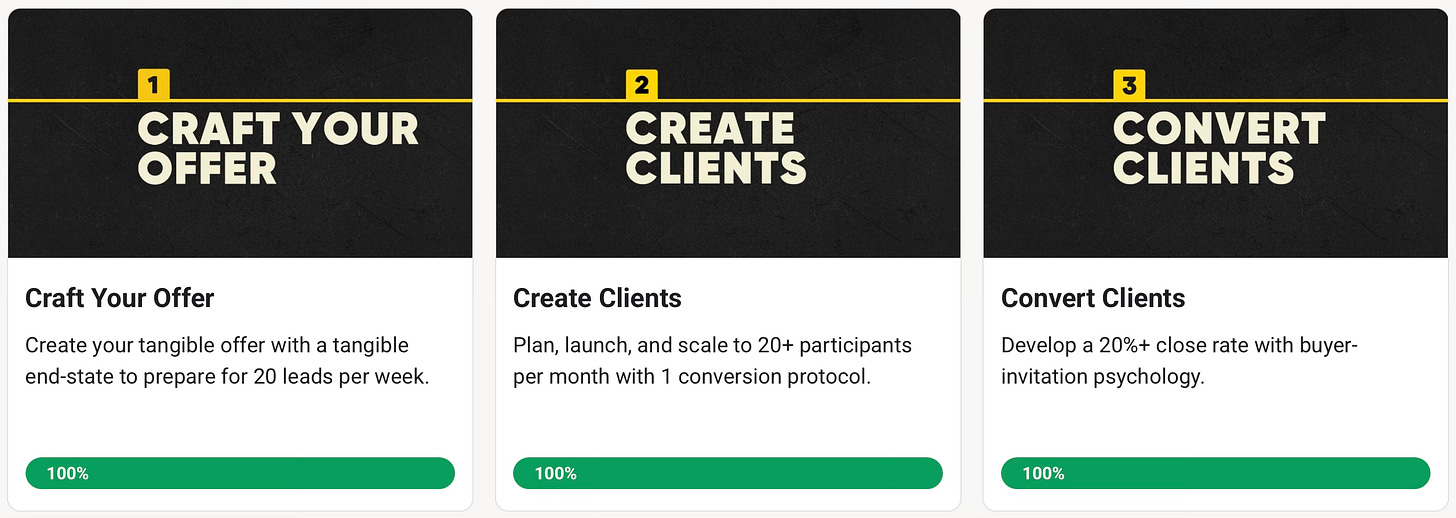The $452K Gap: Why Group Coaching Enables Multi-6-Figure Revenue
I'm convinced: 99% of coaches should have a group offer.
When I first started coaching, I was adamantly opposed to group programs.
Like many coaches, I believed the real value was in personalized, 1-on-1 attention. After all, isn't that what coaching is all about?
The deep conversations
The tailored guidance
Personal connection
But there's a reality where your clients get the personalized benefits above and you get the revenue below without a crazy back-to-back schedule of 1:1’s.
For example, my total earnings for 2024 were $551K:
My group coaching revenue: $452K (with one, 2-hour group meeting per week)
My 1:1 coaching revenue: $99K (with 4+ hours per day of back-to-backs)
That $452K gap is a 456% difference (and less time working per week).
Bonkers. Let that sink in for a moment.
My group coaching earnings weren't just marginally better—they were over-the-moon better. This isn't only a difference in numbers; it's a complete paradigm shift in how I viewed coaching offer sales and effectiveness.
Let’s walk through these insights so you can start adjusting your offer.
Why my group coaching earnings were 456% higher.
At the most basic level, it's 3 tent-pole truths:
The ability to serve more people
The confidence and stability of recurring revenue
The fact that group coaching is actually hyper-personalized
The ability to serve more clients is obvious.
In a 1:1 setting, you can only help 1 person at 1 time. Cool.
In a group setting, you help multiple people at 1 time. Legendary.
But this isn’t about opening the floodgates and letting people pour in.
And I can hear the resistance in your mind: "Group dilutes the coaching experience because it removes personalization."
I get it. I battled with it too.
You know what's crazy? The exact opposite happened and the experience got richer. But we’ll unpack that in a second.
First, let me explain something that’s not so obvious at first:
It’s easier to serve more people in less time.
Key to your group coaching offer is the niche you serve (well, it’s key to every offer if you actually want to sell at a deep and life changing level).
But in group offers it matters for miles and miles.
You see, if you’re serving 1 person, who needs 1 problem solved, and you have 1 offer to solve it, then you’re a speeding bullet on an empty highway.
You use the same material consistently
You establish repeatable systems
You help more people, faster
But if you’re trying to help multiple niches, solve multiple problems, with multiple solutions, then:
You have to custom craft your material (non-stop headaches)
Your systems will require constant nuance and change
You help less people over a longer time frame
Too many people, with too many problems, who need too many solutions. Ugh.
It’s the recipe for 80 hour workweeks, inconsistent breakthroughs, frustrated clients, and small earnings.
Let’s flip it with the most basic niche questions.
WHO do you help?
WHAT do you help them do?
I’ll answer mine so you get ideas for your context:
WHO: Coaches
WHAT: Reach $20K p/m with 1 group coaching offer and 1 free workshop
Notice that my WHO doesn’t say: “Coaches, consultants, fractional entrepreneurs, B2B service providers…”
They all have different needs and execute in various ways. No thank you.
Next, my WHAT contains a tangible end state:
$20K p/m (tangible)
1 free workshop (tangible)
1 group coaching offer (tangible)
It’s a combination of tools + measurable outcomes.
I didn’t write “1 offer,” or “1 course,” I wrote “1 group coaching offer.” It’s specific.
Said another way:
This is who it’s for (Coaches)
This is what we’ll achieve ($20K p/m)
This is how we’ll do it (1 group coaching offer, 1 free workshop)
Is there more to it? Of course. But most people get stuck with the above, skip it, then try to solve it later.
Spoiler alert: they end up with 80 hour workweeks, inconsistent breakthroughs, frustrated clients, and small earnings.
If we can’t answer the niche question at the most basic level, then we can’t answer anything involving our niche at the advanced level.
And what do I mean by ‘advanced level?’ Price. So, let’s talk niche + price.
Know your niche, then charge what you want.
How often do you ask yourself, “What should I charge?”
(and then never really figure it out)
Lots? Same.
But that went away when I picked 1 niche to serve in 1 group model.
For example, I know that the coaches I serve love to “coach” but they don’t always love the “business side of coaching.”
Let me explain.
A career coach loves to help people advance in their career. They want to spend all of their time helping people network, gain visibility, increase job offers, and land the dream role.
That’s coaching.
But a career coach doesn’t necessarily love all that’s involved with marketing, content creation, lead attraction, and of course, sales calls.
That’s the business side of coaching.
After serving hundreds of coaches, I know that coaches tend to fit into one or two of these categories below when it comes to figuring out the business side of coaching:
Some coaches do it in 30 days.
Some do it in 45-60 days.
Others do it 90 days.
Some in 6 months.
(Note: this assumes they’re doing the right stuff on day 1 with the right offer; the more you do what works, consistently, the faster you’ll go and the happier you’ll be)
Because of this, I price my program on a monthly recurring revenue model with a minimum time commitment (3 months) and a recommended time commitment (6 months).
But if I didn’t have 1 targeted niche, then I wouldn’t know this about my 1 niche.
Knowing my niche (and knowing it well) enabled 3 essential sales protocols:
It made it easy for coaches to join without requiring a heavy budget
It gave me breathing room every month with consistent revenue
It enabled price incentives for those who want to PIF
(PIF = Pay in Full)
It also enabled the idea of “Alumni Pricing.”
For example, if you were operating under this model and your client completed their 6 month journey, you could offer a down-sell incentive to stay on board.
This down-sell incentive is known as Alumni Pricing and gives existing clients the opportunity to keep teaming with you at a highly favorable monthly rate.
They get your ongoing feedback. You get a little extra change. Win/win.
Finally, group coaching enables hyper-personalization and efficiency.
I knew group coaching would give me more free time, but I didn't anticipate how I would use that free time to master my offer as a living, breathing, evolving organism.
Here's the beauty of this:
In a group setting, you get more feedback, faster, and from more people. You also see trends in how people think, act, and ask questions. Group coaching = data rich.
So, why do these particular nuances give you an unfair advantage? You get to turn frequently asked questions into core training material.
This enables automation, time freedom, personalization, and efficiency.
For example:
In a 1:1 setting, you have to constantly answer the same questions every time you onboard a new client. You do this manually on a 1:1 call.
But in a group setting, you can transform those commonly asked questions into step-by-step core training material.
Then, during your weekly group calls, you can answer live questions about the core training while communicating additional, deeper nuances relative to the core training.
This is maximum efficiency with hyper-personalization.
Let’s consider my core training for coaches inside the platform, Skool.
When a new coach joins my group program, I invite them to my private Skool enterprise (I don’t call it a community because it’s not, well, an open community).
This is where I house my core training and weekly live coaching sessions.
New clients head to the classroom to watch 3 core modules:
First, they craft their offer
Then they create their workshop
And finish by learning my sales protocols
They’re watching pre-recorded material, then attending live sessions where we get to go deeper (my live sessions are Tuesdays at 3 PM CST).
Between pre-recorded material and live sessions, they are submitting their offer to me inside Skool so I can review and provide personalized feedback.
Plus, they’re getting daily answers from me on all pertinent questions relative to the business side of coaching.
It’s 1 constant well-oiled learning machine.
At the time of writing, I have ~70 clients and work with them for about 1 hour per day in my group (most people don’t have daily questions if your core training is right).
This short, 1-hour is not because I’m hiding in a cave, it’s because the core training covers 90% of why they’re there: the business side of coaching.
The remaining 10%? It’s covered with daily/weekly questions. Easy peasy.
‘Easy peasy’ is what you get with the right niche and the right group coaching model.
Get your core trainings right and everything else will fall into place.
Let’s recap:
Group offers can massively outperform 1:1 offers
Group offers enable you to get time freedom
Group offers work with 1 targeted niche
Thanks for reading this edition, Coach.
Please subscribe (free) for more.
Ryan
Next read: 3 Insights from $551K in Coaching Sales







How can I join the community on Skool?